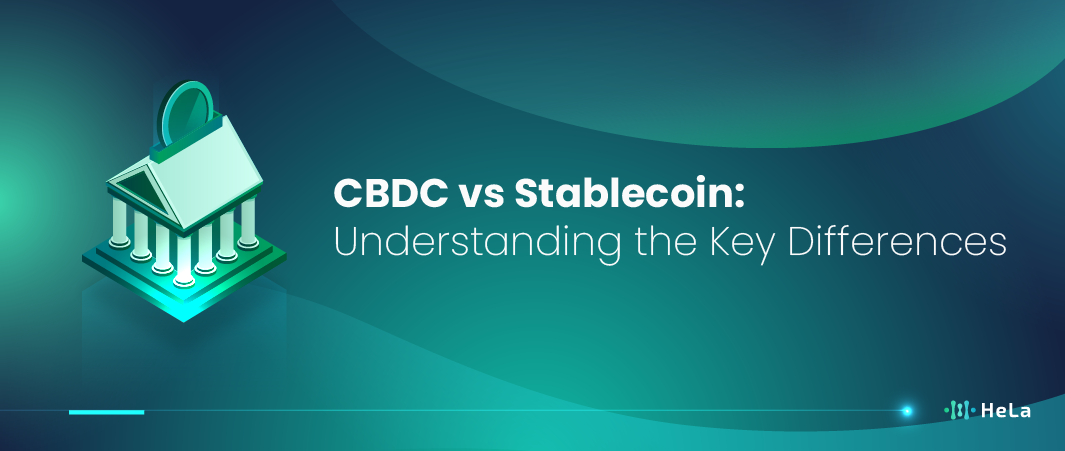As digital currencies gain prominence, two terms that often emerge in discussions are Central Bank Digital Currencies (CBDCs) and stablecoins. Both represent forms of digital money, but they are designed for different purposes and have distinct characteristics. This article aims to clarify the differences between CBDCs and stablecoins, their benefits, and their risks.
Understanding these differences is crucial for anyone interested in the future of digital finance. Whether you’re a policy maker, an investor, or simply a curious individual, knowing how CBDCs and stablecoins operate can provide valuable insights into the evolving financial landscape.
Let’s delve into the specifics of each, starting with what exactly a CBDC is, followed by an exploration of stablecoins, and then we will compare them on various fronts to highlight their key differences and implications.
What is a CBDC?

A Central Bank Digital Currency (CBDC) is a digital form of a country’s national currency. It is issued and regulated by the central bank of the country, just like traditional fiat currency. The primary aim of a CBDC is to provide a secure and efficient means of payment, leveraging digital technology to enhance the monetary system.
CBDCs are designed to be a legal tender, meaning they hold the same status as physical cash and coins. This implies that they are accepted for all forms of payments and transactions within the country. The central bank maintains full control over the supply and distribution of CBDCs, ensuring stability and trust in the financial system.
One of the key motivations behind the development of CBDCs is to modernize the payment infrastructure, reduce transaction costs, and increase financial inclusion. By offering a digital alternative to cash, CBDCs can facilitate faster and more secure transactions, both domestically and internationally.
What is Stablecoin?

Stablecoins are a type of cryptocurrency that aims to offer price stability by being backed by a reserve asset. These assets can include traditional currencies like the US dollar, commodities like gold, or a basket of different assets. The main purpose of stablecoins is to combine the benefits of digital currency—such as fast transactions and low fees—with the stability of traditional fiat currencies.
Also Read: Top 20 Next Crypto to Explode in 2024 (Updated List)
Unlike other cryptocurrencies like Bitcoin, which can be highly volatile, stablecoins are designed to maintain a steady value. This stability makes them useful for everyday transactions, remittances, and as a store of value. They can be used across borders with ease, making them an attractive option for international payments.
Stablecoins are typically issued by private entities, and their value is pegged to the reserve assets held by these entities. This peg is maintained through various mechanisms, including algorithmic adjustments and collateralization. Because of their stable nature, stablecoins are increasingly being adopted in the digital economy, including decentralized finance (DeFi) applications.
Key Differences Between CBDCs and Stablecoins

While both CBDCs and stablecoins are digital currencies, they have several fundamental differences that set them apart. Let’s explore each of these differences in more detail:
Issuer
- CBDCs: Central Bank Digital Currencies are issued by the central bank of a country. This means that they are backed by the full faith and credit of the issuing government. The central bank has the authority to create and distribute the CBDC, much like it does with physical currency and other forms of money. This centralization provides a high level of trust and stability, as central banks are established institutions with the primary role of maintaining monetary stability.
- Stablecoins: In contrast, stablecoins are typically issued by private companies or organizations. These entities create stablecoins to offer a stable digital currency option that can be used globally. The credibility of a stablecoin depends on the reputation and transparency of the issuing entity, as well as the mechanisms they use to maintain the stable value of the coin. This can introduce variability in trust and reliability depending on the issuer’s practices and regulatory environment.
Regulation
- CBDCs: Being a product of central banks, CBDCs are subject to stringent regulation and oversight by the government and the central bank itself. This ensures that the issuance, distribution, and use of CBDCs adhere to strict legal and financial standards. Such regulation is designed to protect users and maintain the stability of the national financial system. Moreover, this regulatory framework allows central banks to use CBDCs as tools for implementing monetary policies effectively.
- Stablecoins: The regulatory landscape for stablecoins is more varied and can be complex. Stablecoins operate under different levels of regulation depending on the jurisdiction. In some countries, stablecoins might be strictly regulated, while in others, they might face minimal oversight. This variability can lead to uncertainties regarding the legal status, compliance requirements, and operational transparency of stablecoins. The regulatory uncertainty can also impact the adoption and trustworthiness of stablecoins among users and investors.
Stability Mechanism
- CBDCs: The stability of a CBDC is inherently tied to the fiat currency it represents. As a direct digital representation of a country’s national currency, a CBDC’s value remains stable and consistent with the fiat currency. This inherent stability is due to the central bank’s control over monetary policy, supply, and demand dynamics. Central banks manage inflation, interest rates, and other economic factors that ensure the stability of the fiat currency, and by extension, the CBDC.
- Stablecoins: The stability of stablecoins is maintained through various mechanisms that aim to keep their value constant relative to a reserve asset. These mechanisms include collateralization (where the stablecoin is backed by assets like fiat currencies, commodities, or other cryptocurrencies), algorithmic adjustments (where smart contracts and algorithms manage the supply and demand of the stablecoin), and hybrid models. Each method has its strengths and weaknesses, and the effectiveness of maintaining stability depends on the robustness of these mechanisms and the transparency of the issuing entity.
Purpose
- CBDCs: The primary purpose of CBDCs is to modernize the existing monetary system. By leveraging digital technology, CBDCs aim to enhance the efficiency, security, and inclusivity of payment systems. They are intended to complement physical cash and improve the overall financial infrastructure. CBDCs can help reduce transaction costs, expedite payment processing, and provide a reliable digital alternative to cash, which can be particularly beneficial in promoting financial inclusion among unbanked and underbanked populations.
- Stablecoins: Stablecoins are designed to provide a stable, digital alternative to volatile cryptocurrencies like Bitcoin and Ethereum. Their primary purpose is to offer a dependable means of exchange, a stable store of value, and a unit of account that can be used for everyday transactions, remittances, and international payments. Stablecoins are particularly useful in the context of the digital economy, including decentralized finance (DeFi) applications, where they facilitate seamless and low-cost transactions across borders and platforms.
Acceptance
- CBDCs: As legal tender, CBDCs must be accepted for all forms of payments within the issuing country. This means that businesses, government agencies, and individuals are legally obligated to accept CBDCs just as they would accept physical cash or bank transfers. This widespread acceptance ensures that CBDCs can be used in a variety of transactions, providing a seamless and integrated experience for users within the national economy.
- Stablecoins: While stablecoins are widely accepted in the digital economy, they do not have the same legal status as CBDCs. Acceptance of stablecoins can vary based on the issuer’s reputation, the regulatory environment, and the specific use case. For instance, stablecoins might be readily accepted on cryptocurrency exchanges and in certain online transactions but may not be universally accepted for all types of payments. Their acceptance also depends on user confidence in the stability and backing of the stablecoin.
Monetary Policy
- CBDCs: Central banks can use CBDCs as a tool for implementing monetary policy. By controlling the issuance and distribution of CBDCs, central banks can influence money supply, interest rates, and other economic variables to achieve desired macroeconomic outcomes, such as controlling inflation or stimulating economic growth. The programmable nature of digital currencies also allows for innovative monetary policy tools, such as negative interest rates on CBDC holdings or direct stimulus payments to citizens.
- Stablecoins: Stablecoins do not have the capability to influence monetary policy directly. Since they are not issued or controlled by central banks, they do not play a role in the implementation of national monetary policy. Instead, stablecoins function within the broader financial ecosystem as stable digital assets that facilitate transactions and value storage. Their impact on monetary policy is indirect, mainly through their influence on the broader adoption and integration of digital currencies in the financial system.
Benefits and Risks of CBDCs
As central banks around the world explore the potential of Central Bank Digital Currencies (CBDCs), it is essential to understand the benefits and risks associated with their implementation. CBDCs promise to revolutionize payment systems and enhance financial inclusion, but they also pose significant challenges that need to be carefully managed.
Benefits
- Enhanced Payment Systems: CBDCs can make payment systems more efficient, reducing transaction costs and processing times.
- Financial Inclusion: By providing digital access to banking services, CBDCs can help bring unbanked populations into the financial system.
- Reduced Fraud and Counterfeiting: Digital currencies are harder to counterfeit, and transactions are more traceable, reducing fraud risks.
- Support for Monetary Policy: Central banks can use CBDCs to implement and enforce monetary policy more effectively.
Risks
- Privacy Concerns: The traceability of CBDC transactions can lead to concerns about privacy and surveillance.
- Cybersecurity Threats: As digital entities, CBDCs are vulnerable to hacking and other cyber threats.
- Disintermediation of Banks: If individuals hold CBDCs directly with the central bank, commercial banks might face reduced deposits, impacting their lending capacity.
- Implementation Costs: Developing and maintaining a CBDC infrastructure can be costly and complex.
CBDCs offer a range of benefits that can enhance payment systems, promote financial inclusion, reduce fraud, and support monetary policy. However, they also come with significant risks related to privacy, cybersecurity, the role of commercial banks, and implementation costs. As central banks continue to explore the potential of CBDCs, they will need to carefully balance these benefits and risks to create a secure and effective digital currency system that serves the needs of their economies and citizens.
Benefits and Risks of Stablecoins
Stablecoins have emerged as a crucial innovation in the world of digital finance, offering a unique blend of stability and efficiency. They are designed to maintain a stable value while providing the benefits of digital currencies, making them an attractive option for various financial applications. However, like any financial instrument, stablecoins come with their own set of benefits and risks that must be carefully considered.
Benefits
- Stability: Stablecoins offer the stability of fiat currencies while maintaining the benefits of digital currencies.
- Fast and Low-Cost Transactions: They enable quick and inexpensive transactions, especially useful for international payments.
- Accessibility: Stablecoins can be easily accessed and used across different platforms and services, increasing their utility.
- Innovation: Stablecoins play a significant role in the growth of the digital economy, particularly in areas like DeFi.
Also Read: Top 10 Layer 2 Ethereum List to Consider this 2024
Risks
- Regulatory Uncertainty: The regulatory status of stablecoins varies widely, leading to potential legal and compliance issues.
- Trust and Transparency: Users must trust that the issuer has sufficient reserves to back the stablecoin, and transparency in this area is crucial.
- Market Risks: If the underlying assets lose value, the stablecoin can also lose its peg, leading to potential losses for holders.
- Technology Risks: Like all digital assets, stablecoins are subject to technological risks, including cybersecurity threats.
Stablecoins offer a compelling blend of stability and efficiency, making them a valuable tool in the digital finance landscape. They provide numerous benefits, including fast and low-cost transactions, accessibility, and support for financial innovation. However, these benefits come with risks related to regulatory uncertainty, trust and transparency, market dynamics, and technological vulnerabilities. As the use of stablecoins continues to grow, addressing these risks will be crucial to ensuring their stability and sustainability in the global financial system.
Conclusion
In conclusion, both CBDCs and stablecoins represent significant advancements in the world of digital finance, but they serve different purposes and come with distinct benefits and risks. CBDCs offer a government-backed, stable digital currency aimed at enhancing the traditional financial system and supporting monetary policy. In contrast, stablecoins provide a private sector solution that combines the benefits of cryptocurrencies with the stability of fiat money.
Understanding the differences between these two types of digital currencies is essential for anyone navigating the modern financial landscape. As technology continues to evolve, the roles of CBDCs and stablecoins will likely become even more pronounced, influencing how we conduct transactions and manage money in the future.
Whether you’re an investor, a policymaker, or simply curious about the future of money, staying informed about these developments will help you make better decisions and understand the implications of digital currencies on a global scale.
Disclaimer: The information provided by HeLa Labs in this article is intended for general informational purposes and does not reflect the company’s opinion. It is not intended as investment advice or recommendations. Readers are strongly advised to conduct their own thorough research and consult with a qualified financial advisor before making any financial decisions.

Joshua Soriano
I am a writer specializing in decentralized systems, digital assets, and Web3 innovation. I develop research-driven explainers, case studies, and thought leadership that connect blockchain infrastructure, smart contract design, and tokenization models to real-world outcomes.
My work focuses on translating complex technical concepts into clear, actionable narratives for builders, businesses, and investors, highlighting transparency, security, and operational efficiency. Each piece blends primary-source research, protocol documentation, and practitioner insights to surface what matters for adoption and risk reduction, helping teams make informed decisions with precise, accessible content.
- Joshua Soriano#molongui-disabled-link
- Joshua Soriano#molongui-disabled-link
- Joshua Soriano#molongui-disabled-link
- Joshua Soriano#molongui-disabled-link

